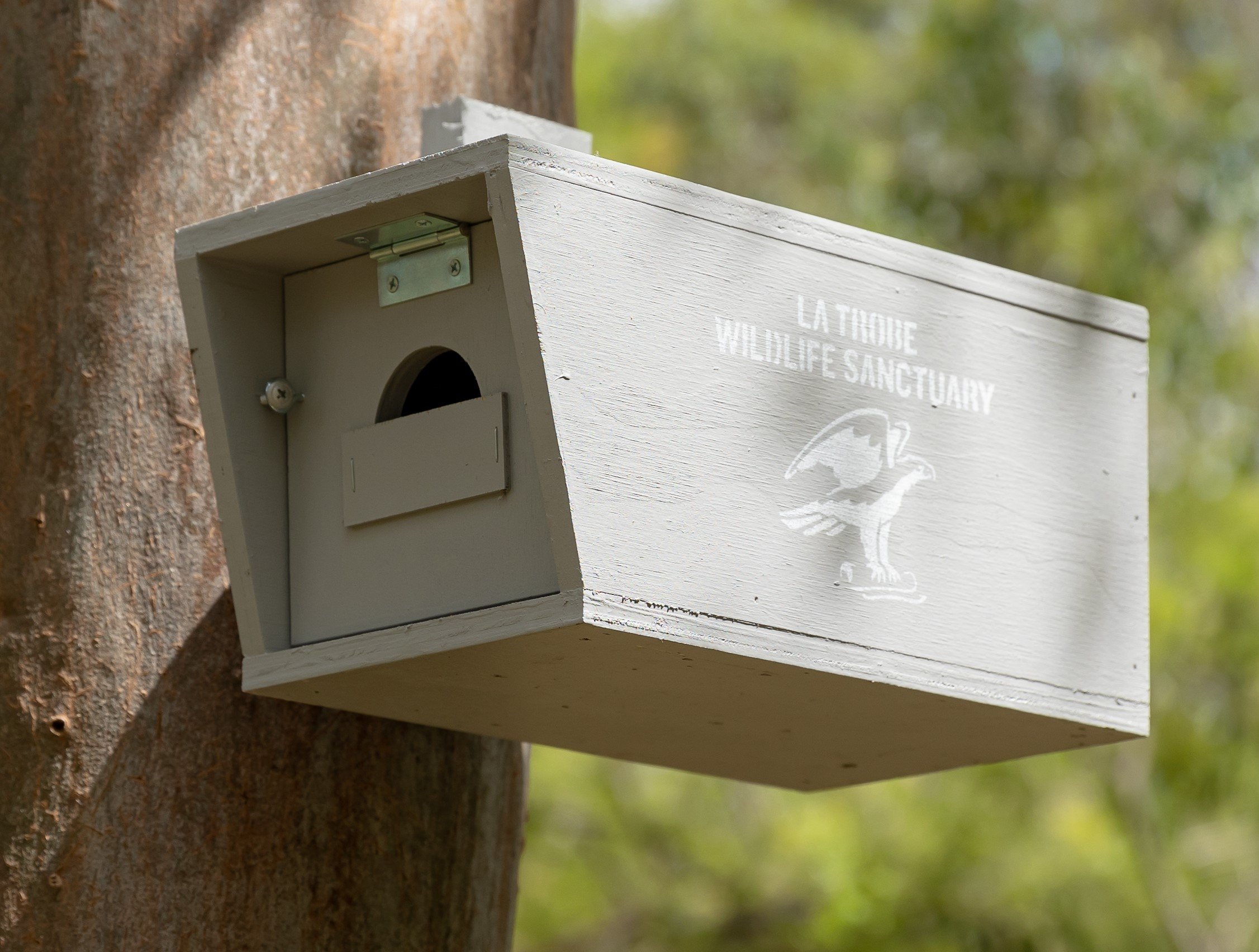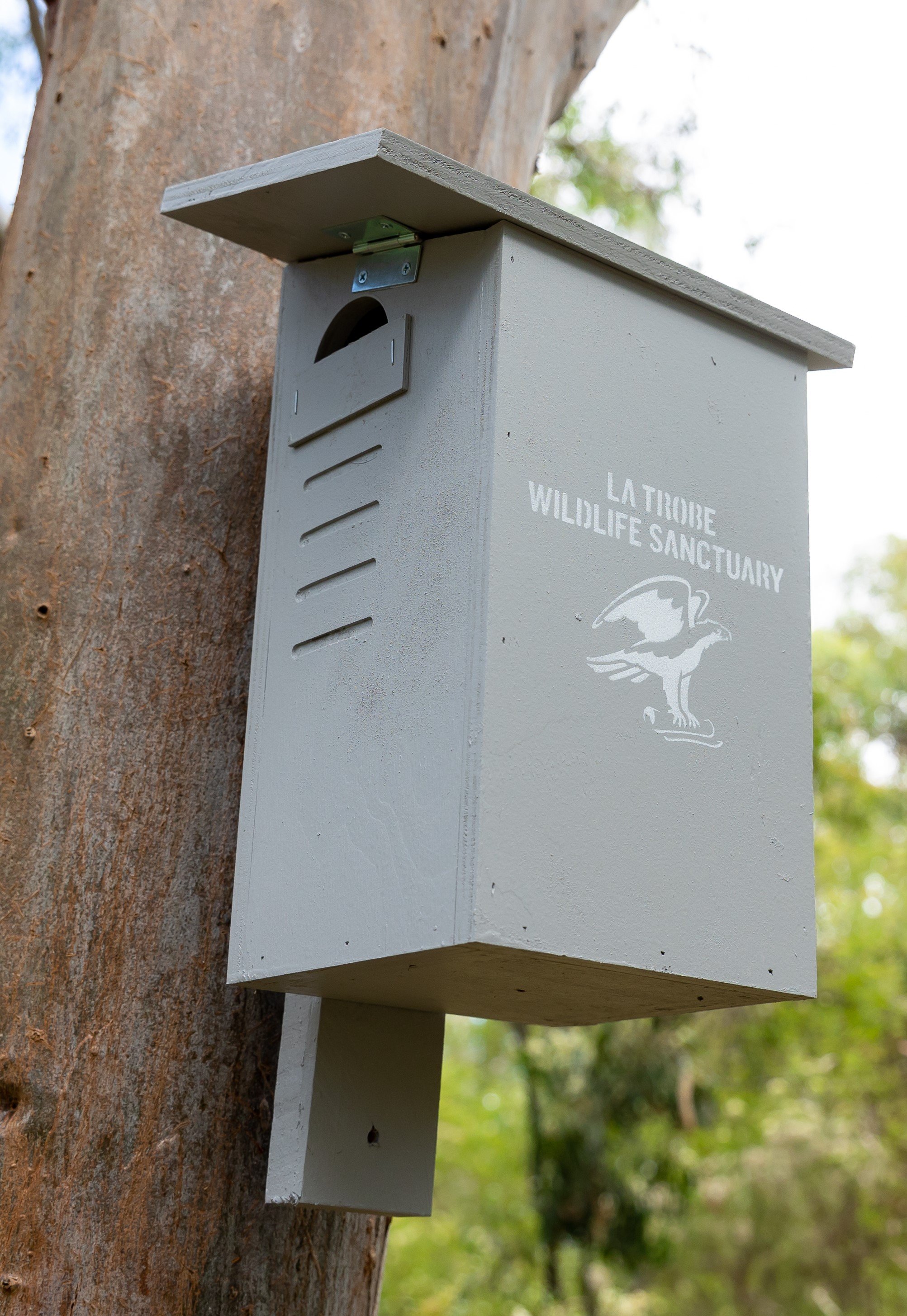Nesting boxes
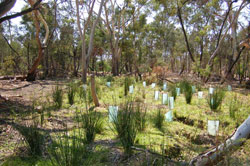
Nesting boxes are artificial hollows that provide habitat to native wildlife. They are useful in providing supplementary habitat, particularly in suburban areas, where older trees are lacking.
Many of our Australian wildlife species rely on tree hollows for roost and nest sites (17% of bird species, 42% of mammals and 28% of reptiles). This includes possums, sugar gliders, parrots, microbats, phascogales and owls.
Natural tree hollows can take upwards of 100 years to form. Land clearing, urbanisation and other human impacts such as fire means that hollows are not as readily available as they once were.
About Our Boxes
The design of our nesting boxes has been refined over 30 years of using them within the Sanctuary to provide supplementary habitat for native wildlife. This has enabled us to ensure that they have the appropriate features for the target species as well as being easy to install, lightweight, durable and a cost effective solution for our customers.
Our boxes are made out of 12mm CD plywood (FSC certified) and covered with two coats of a low VOC, water-based paint (exterior surfaces only). Hardwood boxes are also available by custom order (see FAQs below for more information).
Boxes are designed to last up to 10 years (with basic maintenance) depending on various factors including climatic conditions, exposure and the species utilising the box. Basic maintenance includes replacement of hinges/lids or repainting (particularly the lid).
We currently have 14 different nesting box designs available. All designs are available as assembled boxes or flatpack kits (all screws, nails and hinges are provided).
We have recently changed the colour of our boxes from dark green to light grey - you can read more about the reason for this change in the FAQs below.
| Box type | Box features/ placement | Cost | Image |
|---|---|---|---|
Antechinus, Phascogale, Squirrel Glider These three mammals all have similar nesting requirements so this box will suit multiple species. Phascogales are a little-known native marsupial. They feed on insects, centipedes and the nectar of box and ironbark eucalypts. To attract Phascogales, consider planting box, ironbark and/or stringybark eucalypts. The also require a dense layer of fallen logs, bark and leaves to hunt their prey. Antechinus are a shrew-like carnivorous marsupial that live in trees and feed on invertebrates including spiders, beetles, worms and grubs. To attract Antechinus, consider planting insect attracting plants including Callistemon, Hakea and Acacias. Squirrel Gliders are little known and rarely seen possums. They have webbing between their front and back paws which allow them to glide between trees. To attract Squirrel Gliders consider planting indigenous plants that flower at different times of the year. The flowers will provide nectar and attract insects for them to eat. | Position the box in an evergreen tree close to dense foliage and close to other trees and shrubs. These mammals do not like to be exposed for long periods of time. The nesting box does not need to be cleaned. These mammals defecate in their box, but it is perfectly normal and should be left like that. | Assembled $88 Flatpack $76 | 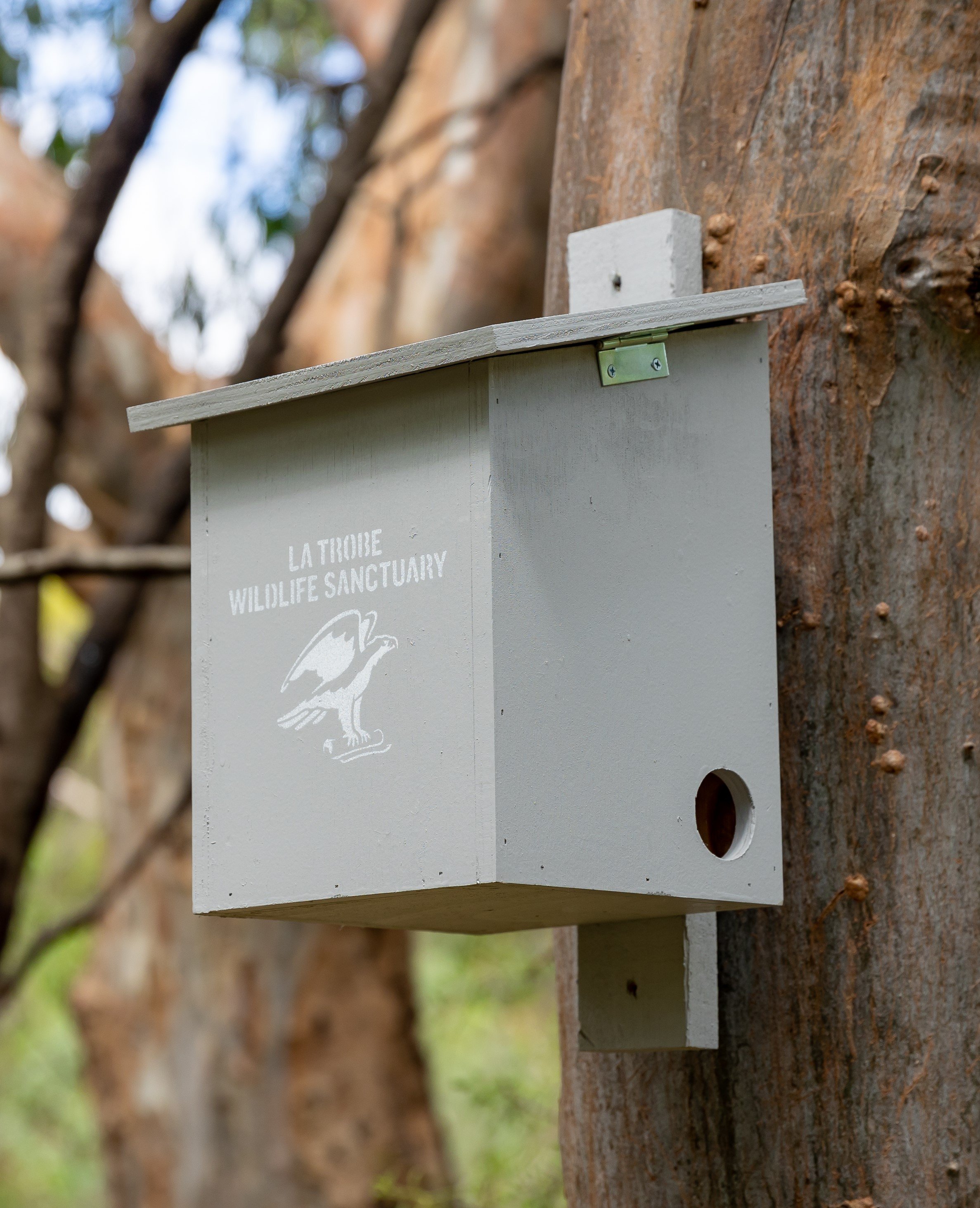 |
Brushtail Possum Brushtail Possums are highly territorial and will generally live a solitary life, except when they come together to mate. If possums are a problem in your garden, consider locating roses and fruit trees away from large trees and fences (possum access points) and planting a range of indigenous plants to provide an alternative food choice. Remove access branches to stop possums getting into your roof. To ethically remove possums, contact a fee-for-service possum remover. | If possible, place the box in a tree close to other trees and shrubs. The nesting box does not need to be cleaned out as Brushtail Possums keep their nest clean and tidy. The entrance hole may seem small, but this does not prevent entry by possums and helps to deter predators. Brushtail Possums are used to squeezing into small spaces! Our possum boxes are made without grooves. Possum claws are strong enough to cling to the plywood surface, and the boxes are not deep enough to require a ladder. | Assembled $108 Flatpack $92 | 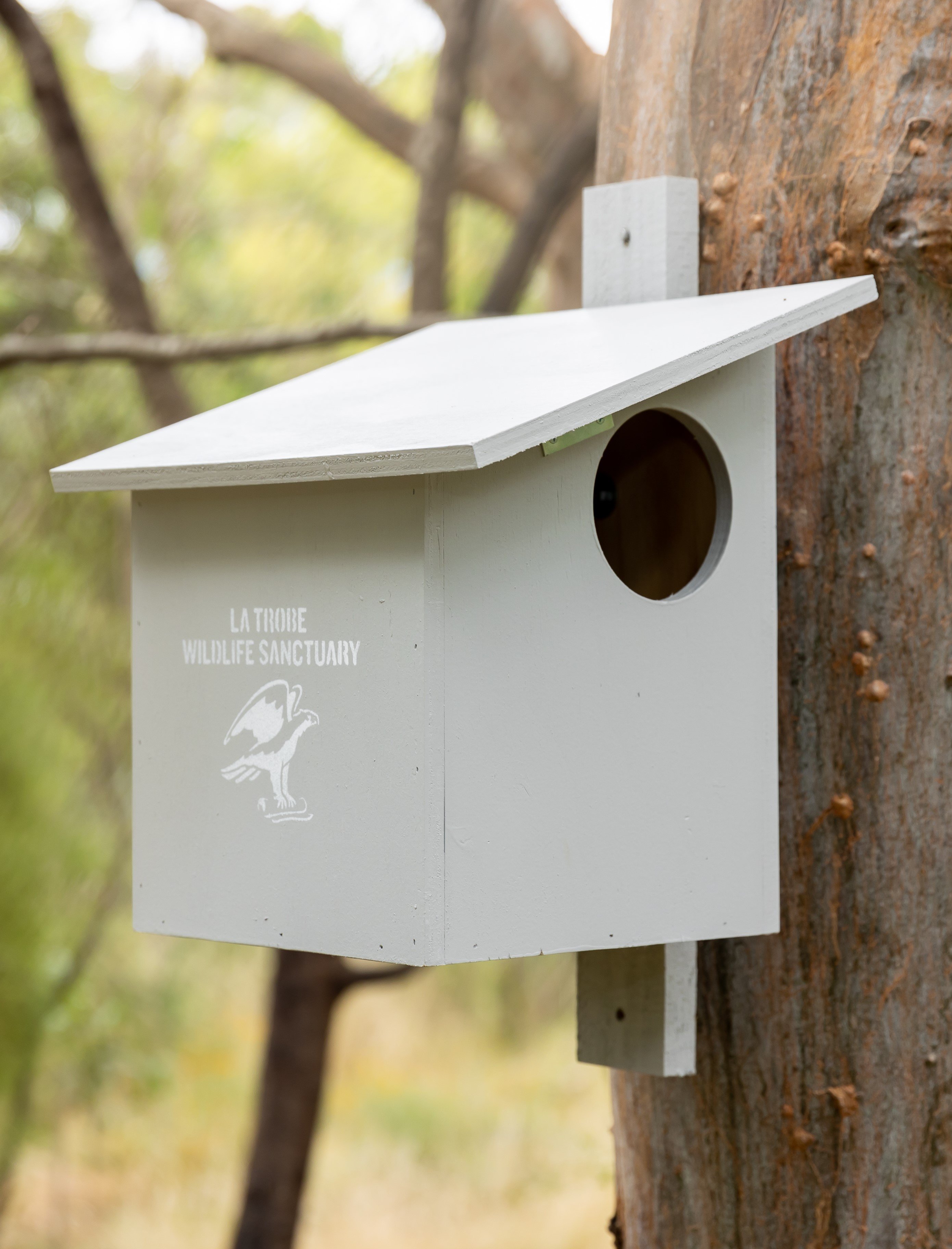 |
Microbat This box is suitable for several species of the smaller microbat (not for its larger fruit loving cousins – flying foxes). You are most likely to see these Microbats out and about on a warm night, hunting for insects in your local neighbourhood. They use echolocation (a type of sonar) to locate their prey. To attract Microbats to your garden, consider planting indigenous plants that attract insects. A few plants to consider include members of Callistemon, Hakea, Eucalyptus, and Acacia | Designed to avoid the build up of scats (guano). Inside of the box has grooves which the Microbats will use like a ladder. Should be placed in a semi-open area. Microbats tend to move between homes each night, so it can be a good idea to install a few boxes. Put a Microbat box near your backyard ponds to help control mosquitos! | Assembled $82 Flatpack $67 | 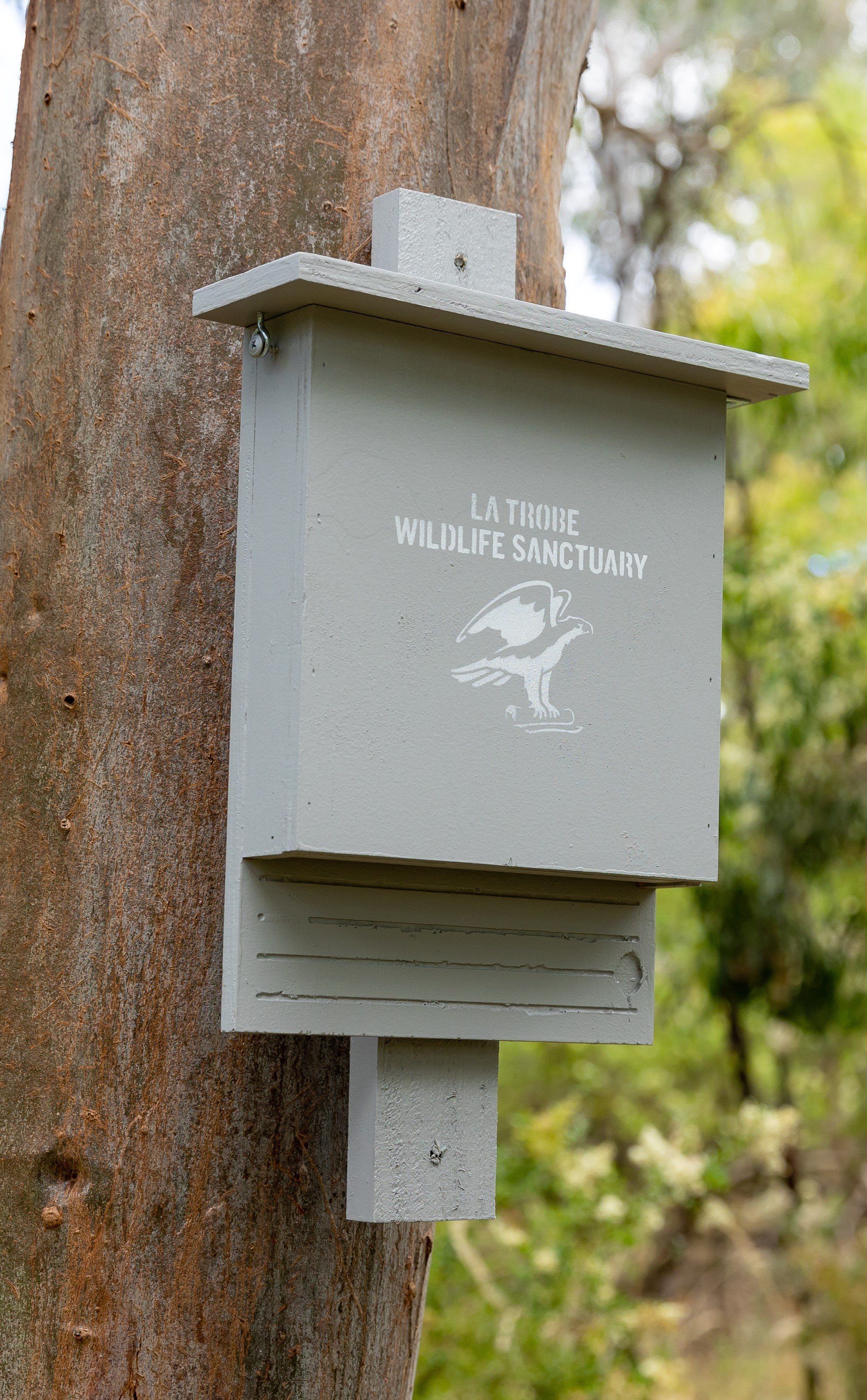 |
Ringtail Possum Ringtail Possums nest in small family groups. They feed on the flowers, foliage and fruit of many plants and are extremely adaptable. Unlike the larger Brushtail Possum, Ringtail Possums rarely enter the roofs of buildings. But they are known to quite happily nest in garage roller doors or dense climbing vegetation adjacent to a house. | If possible, place the box in a tree close to other trees and shrubs. The nesting box does not need to be cleaned out as Ringtail Possums keep their nest clean and tidy. The size of this entrance hole will allow Ringtail Possums access, but exclude large Brushtail possums. Our possum boxes are made without grooves. Possum claws are strong enough to cling to the plywood surface, and the boxes are not deep enough to require a ladder. | Assembled $84 Flatpack $72 | 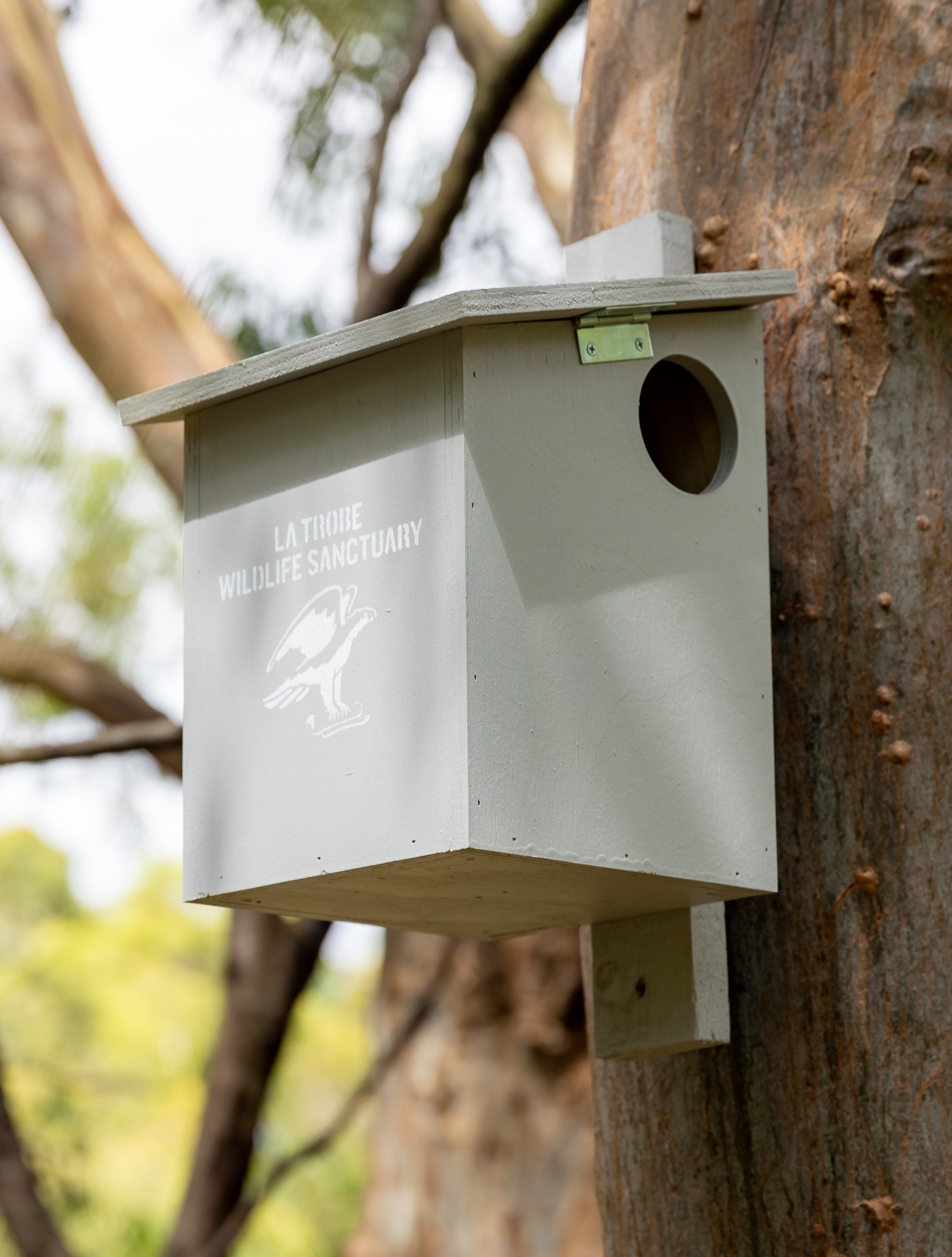 |
Small Glider Our local small glider is the Krefft's Glider, they are small possums that occur in densely wooded suburbs, parks and reserves around Melbourne. Other small gliders include Sugar Gliders and Savannah Gliders. All small gliders have webbing between their front and back paws that allow them to glide between trees – flights over 50m have been recorded! They feed on insects, nectar and tree sap and have been known to prey on juvenile birds. To attract gliders to your garden, consider planting members of Acacia and Eucalyptus which provide shelter and food in the form of nectar and sap. | The box as a small entry hole and an inbuilt excluder which prevents other animals from entering or causing harm. Position the box in an evergreen tree close to dense foliage and close to other trees and shrubs. Gliders do not like to be exposed for long periods of time. The nesting box does not need to be cleaned out as Gliders keep their nest clean and tidy. | Assembled $93 Flatpack $81 | 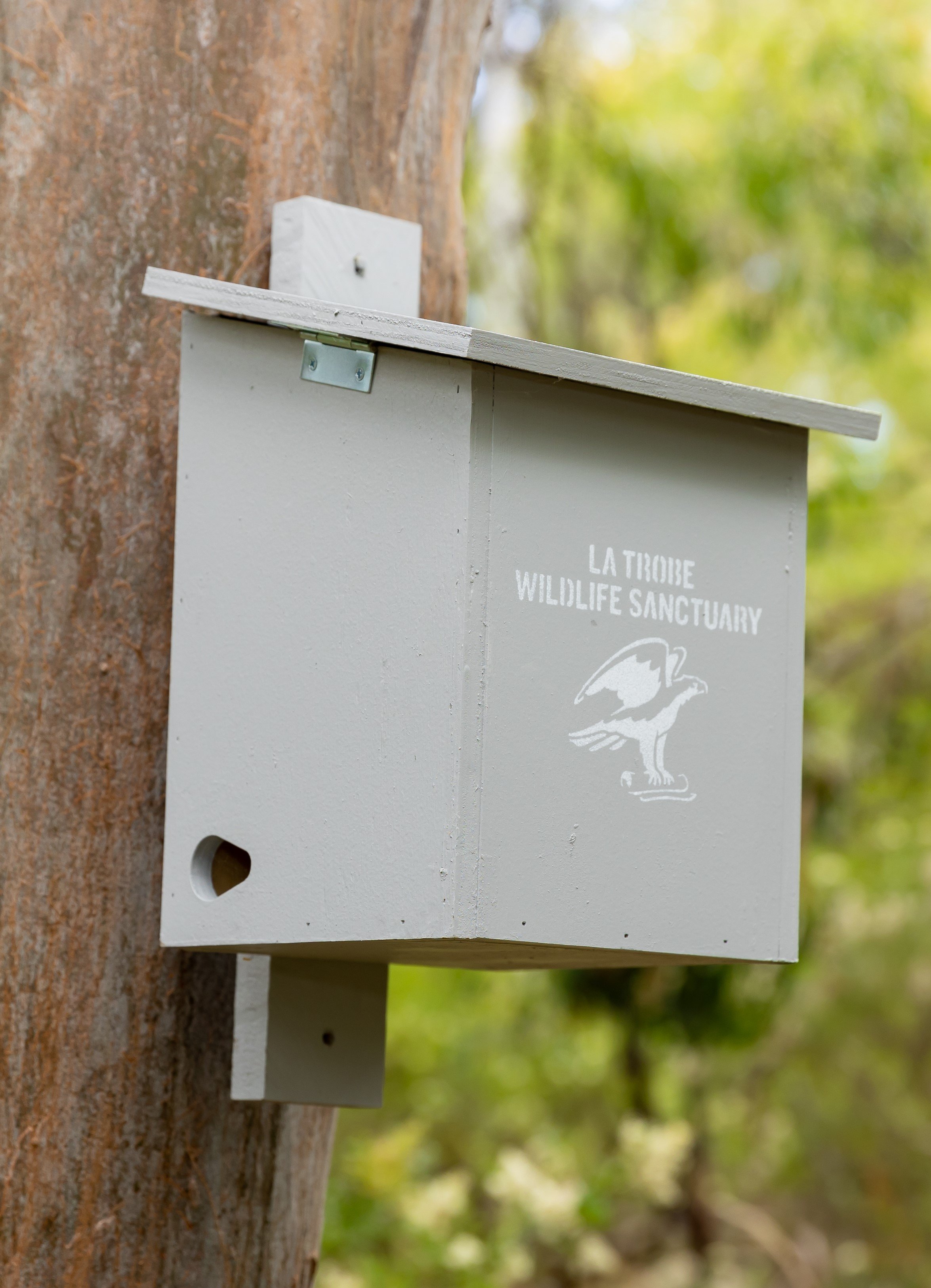 |
Feathertail Glider Feathertail Gliders are small, gliding possums that can glide between trees and over open spaces. These gliders tend to live in the outer suburbs of Melbourne where there is good tree cover and a dense understory. They eat a range of foods including insects, nectar from flowers and tree sap. To attract Feathertail Gliders to your garden, consider planting a range of indigenous plants that flower at different times of the year. The flowers will provide nectar and attract insects for the gliders to eat. Wattle trees provide a good source of food during the winter months. | The tiny entrance hole keeps larger animals out, protecting the gliders from predation or being disturbed. This is especially useful for when the Position the box in an evergreen tree close to dense foliage and close to other trees and shrubs. Feathertail Gliders do not like to be exposed for long periods of time. The nesting box does not need to be cleaned out as Feathertail Gliders keep their nest clean and tidy | Assembled $71 Flatpack $60 | 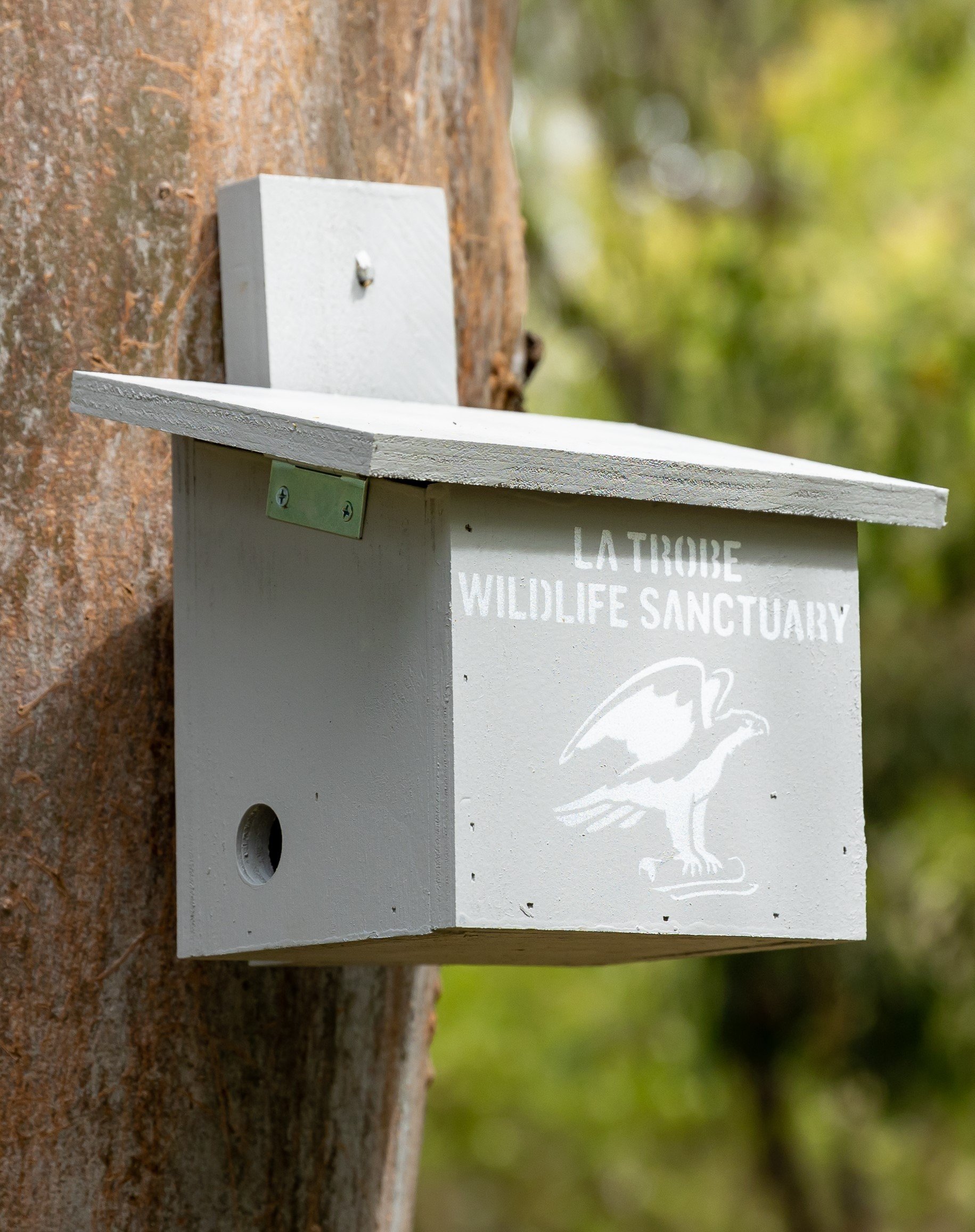 |
Pardalote Pardalotes are small insectivorous birds that breed in long tunnels dug into the earth or in tree hollows.
| Included is a bag of potting mix that should be emptied into the bottom of the nest box. Pardalotes favour a loose substrate, so it is important to keep the nesting box topped up. Place the box high enough to keep it out of reach of cats | Assembled $73 Flatpack $59 | 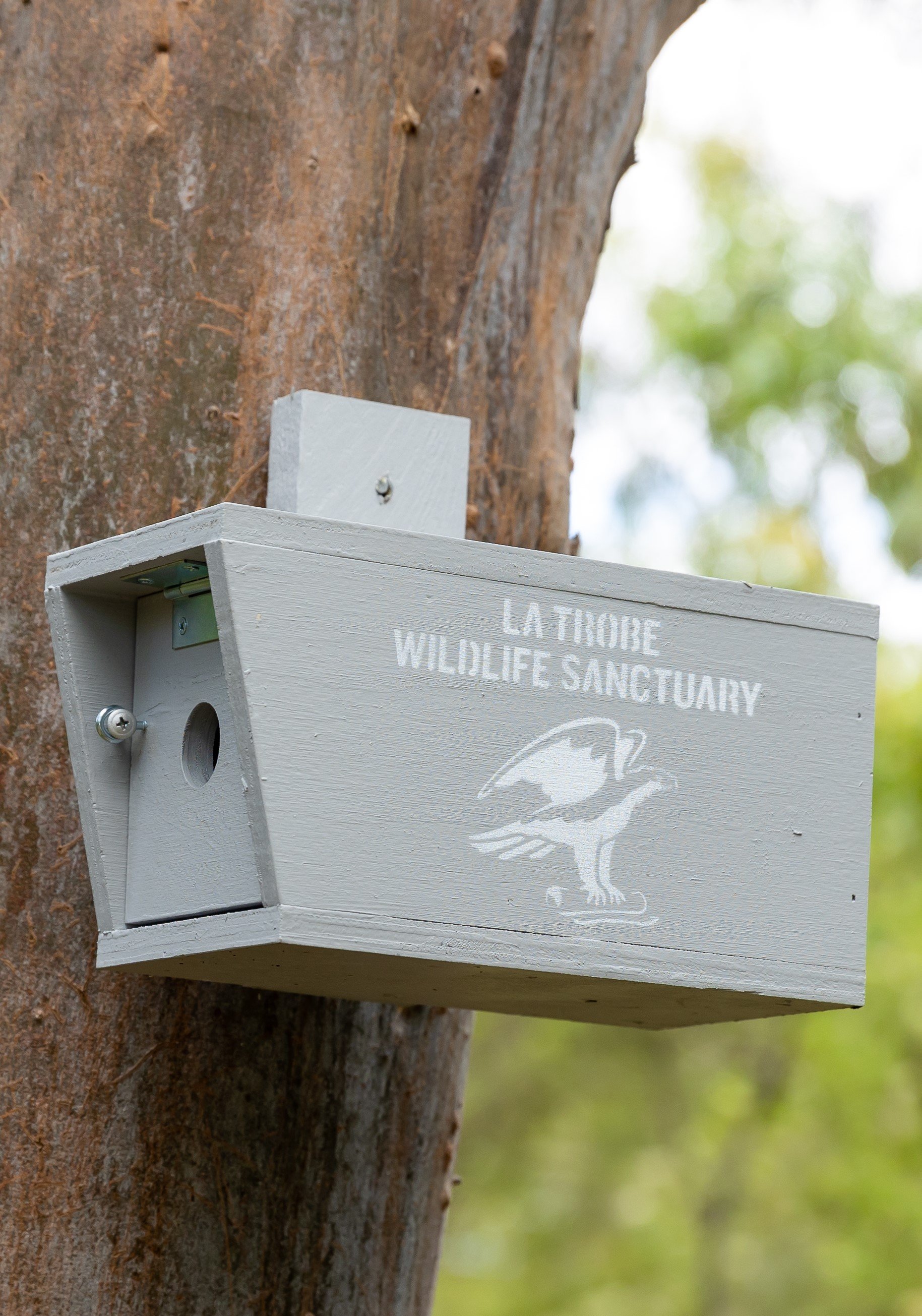 |
Lorikeet, Small Parrot and Medium Parrot Many parrots are dependent on tree hollows for breeding. With natural hollows quickly disappearing due to the pressures of urban development, nesting boxes are a great way to protect these native birds. To attract small parrots to your garden, consider planting plants that produce high amounts of pollen and nectar, especially eucalyptus trees. Parrots are known to follow the flowering seasons of various species – so providing a range of plants that flower in different seasons will encourage them to stick around. Also consider planting native grasses, as some parrot species will feed on the grass seeds. Lorikeet boxes will be suitable for most lorikeet species such as Rainbow Lorikeets, Musk Lorikeets and Purple-crowned Lorikeets. The Small Parrot box will suit a range of smaller parrot species such as Red-rumped Parrots and Eastern Rosellas, while the Medium Parrot box will suit slightly larger species such as King Parrots, Crimson Rosellas and Regent Parrots. | The box includes an exotic bird excluder, or baffle, which prevents invasive species such as Indian Mynahs and Starlings from occupying the box. Native parrots will chew through the excluder to access the box. Included is a bag of potting mix that should be emptied into the bottom of the nest box. This allows the nest box to better mimic their natural nesting sites in rotting wood. A parrot nest box should only need to be cleaned out if a feral species has nested in it. Feral species will fill the box with twigs, feathers and bright coloured rubbish that will discourage parrots from using the box. Parrots keep their nest clean and tidy; so there is no need to add or change nesting material once the box is installed. Place the box high enough to keep it out of reach of cats. The boxes should be exposed to morning sun to help warm it after cold spring nights. | Lorikeet Flatpack $67 Small Parrot Flatpack $78 Medium Parrot Flatpack $98 |
|
Duck Ducks have lived in and around our waterways for centuries; thriving even in urban areas. Whilst some ducks nest on the ground, others are dependent on tree hollows to protect their young from predators. Our nesting box meets the requirements of a number of duck species, including Wood Ducks, Chestnut Teals, Grey Teals and even Pink-eared Ducks. It is quite difficult to attract ducks to your garden unless you have a large body of water that has aquatic plants growing in it. They prefer to feed on young green grass or herbs, aquatic seed and herbaceous aquatic plants | All ducks have different preferences when it comes to the height of the nesting box or hollow. If you are trying to target a specific species then you may need to find out what is the optimum height for that species. Ducks defecate over the edge of the nest opening. So place your box where there is no human traffic underneath! A duck nesting box is designed not to attract bees or non-native birds, even if it is vacant. Ducks will evict any unwanted animals from their nest, so they’ll do the policing for you. Place the box in a tree close to other trees or shrubs. Ducks will sit on the nest box perch while it is being used for breeding. Ducks will only use the box during their breeding season (spring). | Assembled $133 Flatpack $114 | 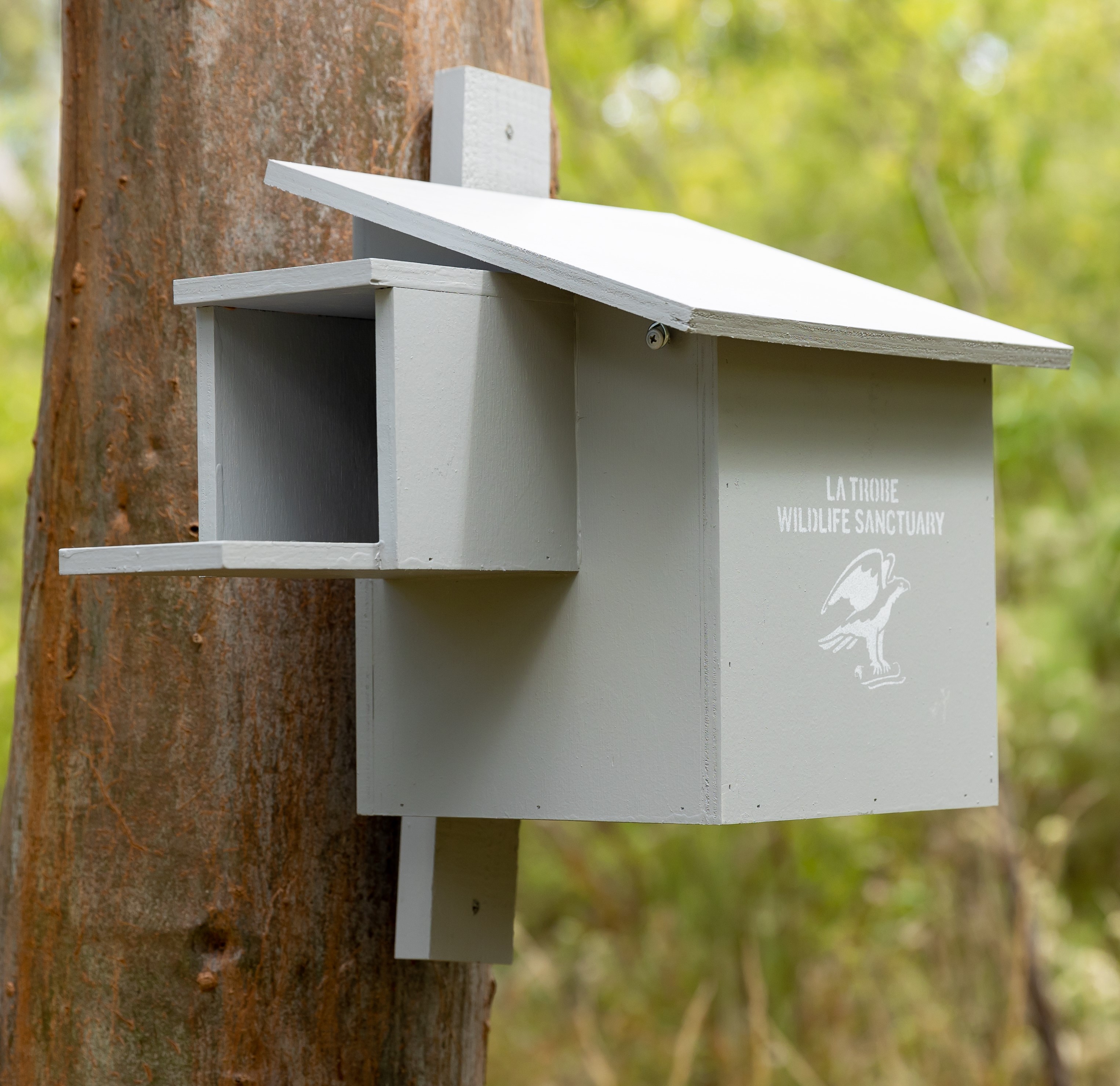 |
Kookaburra The Kookaburra box meets the requirements of two species of kookaburra, the Laughing Kookaburra and the Blue-winged Kookaburra. These large, loud and cheeky birds add life to any area. To attract kookaburras to your garden, consider managing your garden for other wildlife. A frog bog or lizard lounge will attract larger prey items such as frogs and lizards. Also consider planting indigenous plants that attract insects, such as Callistemon, Hakea, Eucalyptus, and Acacia. | It is best to place the box in a semi-open position, preferably on an evergreen tree close to other shrubs and trees Kookaburras will sit on the perch while using the box for breeding. A Kookaburra nest box does not need to be cleaned out. Young Kookaburras defecate over the edge of the nest opening. So place your box where there is no human traffic underneath! Kookaburras will evict any unwanted animals out of their nest (including European Bees) Do not approach occupied boxes and avoid any major disturbances Kookaburras will only use the box during breeding, from September to January. | Assembled $128 Flatpack $109 | 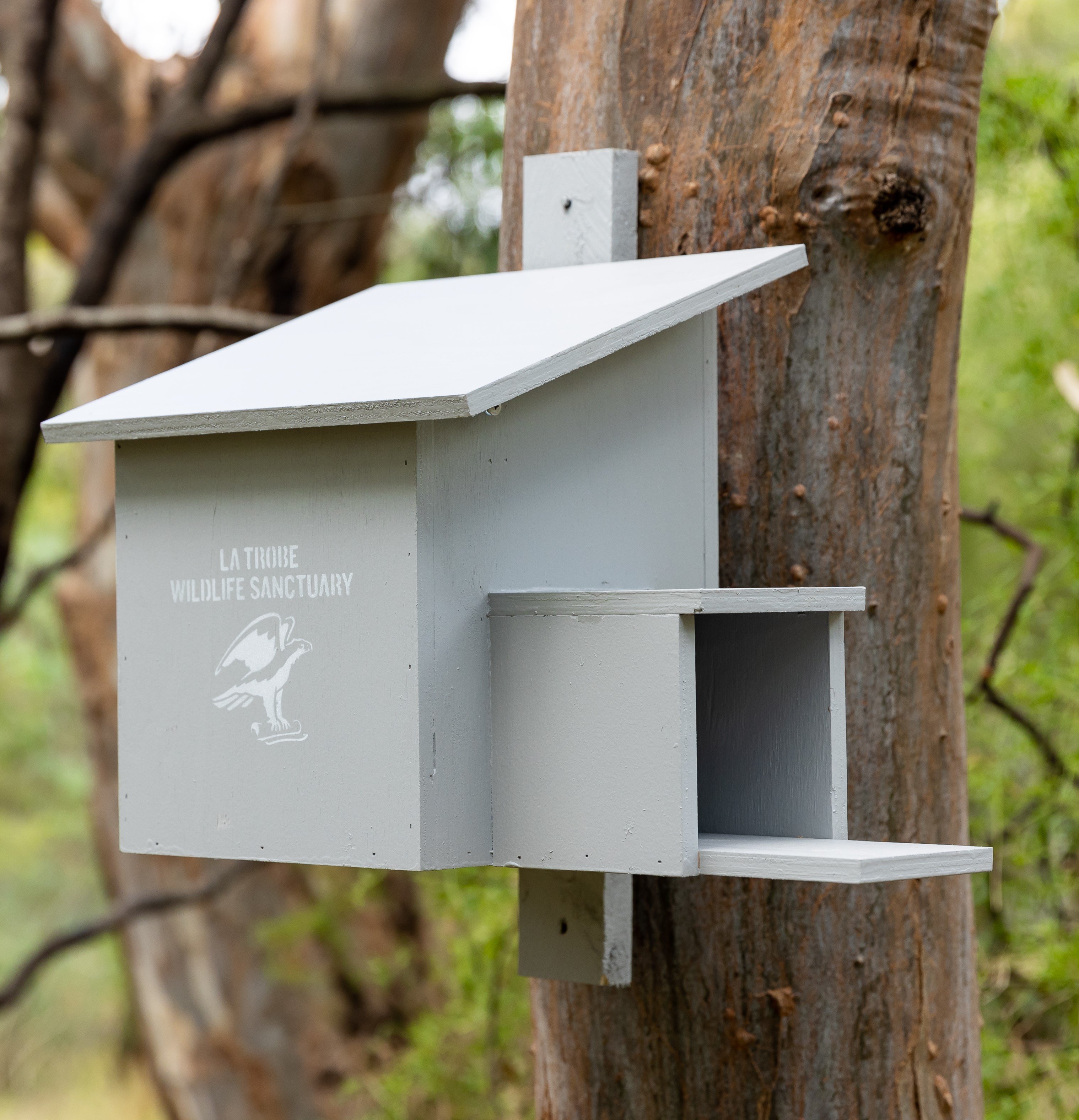 |
Owl Owls travel at night, using their incredible night vision to spot and catch prey such as small mammals, rodents, lizards and invertebrates. Being high on the food chain, owls often have very large home ranges and can travel far in a single night. Several species of owl might use this box, including the Southern Boobook owl, Barn Owl and Owlet Nightjar. To attract owls to your garden, consider planting a range of native plants that attract other animals, such as rodents and possums. Managing your garden for habitat, by creating a frog bog and/or lizard lounge and allowing a complex litter layer to build up, will attract a wider suite of animals and provide a better pantry for owls. | Owl boxes are best placed as high as possible in the tree. This may mean that you need to engage the services of a properly trained person to install your owl box. Owls will typically add chips or bark or leaves to their nest, so for this reason so provide you with a bag of potting mix. the owls will add other materials as necessary. | Assembled $143 Flatpack $123 |  |
Purchasing nesting boxes
Retail shop
We stock the full range of nesting boxes in our Retail shop. We recommend that you get in touch before making a special visit to check that we have them in stock.
We are located on the La Trobe University, Melbourne (Bundoora) campus. Access is via La Trobe Ave (near the roundabout on Main Drive).
Contact us:
T: (03) 9479 1206
E: wildlife@latrobe.edu.au
Opening hours vary at different times of the year, please check here for current hours.
Our Retail shop also propagates and sells over 300 species of indigenous plants, perfect for enhancing the biodiversity in your backyard!
Online store
Flatpack kits and selected assembled boxes are available for postage. Postage cost depends on box type and location (ranges from $24 to $34 per box) - please make sure you select the appropriate freight option for your location/box type at checkout.
Unfortunately we are not able to offer postage to WA or NT through our online store, please contact us for a shipping quote.
If you are ordering more than 5 boxes, you can also contact us for a shipping quote as we may be able to offer a bulk rate.
All boxes are available to purchase at our nursery (open Sunday to Friday, 10am-3pm).
Bulk orders
- Orders over 30 boxes receive a 5% discount
To order bulk boxes, please contact us directly for a quote.
Boxes on Public Land
Contact your local council to find out about their policy on installing nest boxes and to get official permission, before you purchase your boxes. (See below for FAQs)
FAQs
- Physical structure of the vegetation (height, thickness etc of vegetation)
- Distance from/availability of food resources
- Competitors for food and shelter
- Territorial size/behaviour of the target species
- Weather/climatic conditions
- Presence and abundance of predators
- Brushtail Possums are highly territorial, so you would only want one box in a regular suburban backyard.
- Unlike Brushtail possums, Ringtail Possums live in family groups and may use several dreys/nesting sites.
- Do not put Brushtail and Ringtail Possum boxes in the same tree or very close trees to stop competition.
- Lorikeet and Rosella boxes should not face each other due to potential competition/aggressive behaviour.
- Microbats will nest in small colonies and the placement of several boxes may allow multiple species to nest on your property. Individual colonies may also use several roost sites in summer and winter and as a way to minimise infestation of ectoparasites, such as mites.
- Although we don’t generally recommend putting more than one box in a tree (unless it is a very large tree), you could put a Microbat box (facing south-west) and another box (facing east) in one tree.
There are multiple factors that impact suitable nesting box density and diversity in a given area:
The Nangak Tamboree Wildlife Sanctuary can give you some general recommendations about what boxes might be suitable in your area, but keep in mind that we are not experts on all areas of Australia. If you aren’t sure what animals occur in your local area, we suggest that you so some observing of wildlife in your backyard/property and in surrounding areas where there may be better habitat. You can also try contacting your local council or Landcare group, or have a chat to people in your neighbourhood, to see what species you should be targeting.
Generally, we would recommend that you start with one box per species and then increase the number each season as they (hopefully) breed and increase the population.
Here are some general rules/things to consider when selecting boxes:
- Choose an easily accessible spot away from bright lights.
- The box should be at least three metres from the ground*.
- The box should be facing east and be shaded through the hottest part of the day. This is because most cold weather comes from the south.
- Generally, you should only put one box per tree (see below for some exceptions).
- Ideally boxes should be installed in a tree, however they can be installed on the side of a house/shed if there are nearby accessible trees (eg. if possums are currently residing in the roof).
- Once you have decided on a location, set the angle of the backboard and tighten the bolt. To ensure that it is secure hammer the small nail (supplied) through the back of the box into the backboard Each nesting box is provided with 4” galvanised nails and mudguard washers. Thread the nail through the washer and then through the backboard of the nesting box. Nail it firmly to the tree. As the tree grows the box is firmly held into place by the two large mudguard washers.
- We use nails instead of strapping because over time strapping strangles the tree, causing the tree to drop its limbs or die
- Animals are naturally curious and will investigate any new objects in their territory. They will soon locate your new nesting box – you won’t be able to hide it from them.
*We recommend having a properly trained person install boxes at height, eg. an arborist or some environmental consultants should be able to do this.
The time it takes for animals to move into your box will depend on what species it is, time of the year and surrounding environment. Wildlife will know that the box is there straight away and will move in when they are ready.
For example, if you are installing a Brushtail Possum box because you are evicting them from your roof, you might find that the box is inhabited very quickly. Whereas, if you put up a Rosella box because you regularly see them feeding in your backyard, it might not be until the next breeding season is over and the fledglings have left home to go and find a site to breed themselves that you get inhabitants.
The best advice we can give is to put up the box and let the animals do their thing in their own time.
If you spot the first ‘scout’ bees entering a nesting box, you can spray them with a garden hose. You may want to use caution around the entrance hole if you suspect there is native wildlife in residence.
If bees have taken up residence, insect powder on a ‘pest strip’ placed in the hole should eliminate them without any detriment to native wildlife. Make sure you use a non-residue insecticide, usually branded as wasp control, usually with the active chemical being d-Allethrin and/or d-Phenothrin. Do not attempt to collect and eat any of the honey comb, but these non-residual chemicals are safe for animals so you can leave the honeycomb for wildlife such as gliders and possums to eat. Otherwise, you will need to remove the box to clean it out before reinstalling it.
To deter bees in the first place, you can fill the nesting box with fresh gum leaves on installation.
We regularly get asked about the best cameras to use to monitor nesting boxes or how often you should open the lid to check them. While pictures of wildlife, especially juveniles, curled up in a nesting box are cute, any invasive and regular checking of nesting boxes can be detrimental to the species that you are trying to provide a home for. For example, if you disturb a sitting bird, it may cause her to abandon her nest.
A better way to monitor who is using your nesting box is to look for indirect evidence. Are there scats on the ground or nearby? Can you see any chew marks or scratches around the entrance hole? Has the baffle on a parrot box been chewed away?
If you want direct evidence of nesting box utilisation, you can station yourself near the box at dusk when animals are emerging to forage for the night. Watch the box for 20-30 minutes and see who emerges.
Alternatively, you could set up a wildlife camera (aka. trail camera, camera trap) on a tree facing the nesting box entrance. Wildlife cameras can be set up to take photos at certain time intervals, times of the day or to be motion triggered and depending on the brand, batteries can last several weeks. Just be careful about where you place them so that you don’t end up with countless photos of branches blowing the in the breeze.
We may have the capacity to customise the design of our standard boxes as part of a research project. This has been done previously to incorporate sound recorders or to enable monitoring by a specific camera.
If you would like to modify one of our designs, please send us detailed drawings (with dimensions) and we will provide a quote for the customisation.
Our standard boxes are 12mm CD plywood. Plywood is lightweight (making installation easier), has sufficient insulating properties for most regions of Australia and durable enough to last up to 10 years with some basic maintenance.
We are also able to make boxes to order using 15mm exterior hardwood. Hardwood can last 15-20 years (or longer with some maintenance), so may be appropriate for large projects where maintenance of boxes is not possible or reduced. The thicker wood will also offer additional insulation in areas which experience extreme temperatures. The downside of hardwood is that it is not as readily in supply as plywood (so boxes will be more expensive) and it is much heavier (which will make installation more difficult).
Contact us for a hardwood nesting box quote. Please allow a minimum of 4 weeks to construct hardwood boxes (we can provide a more accurate timeframe when quoting).
Due to recent research and customer demand we have decided to make a change to the colour of our nesting boxes.
Although dark colours can be a benefit to wildlife in the cooler months, they tend to heat up significantly in summer and can cause heat stress of the occupants (Griffiths et al 2017), particularly those that are not tolerant of high temperatures such as Common Ringtail Possums.
Due to recent research into paint colour and the thermal qualities of nest boxes we have decided to change from a dark green paint to a light grey paint.
The light grey colouration also blends in better with the typical muted greys of smooth barked Eucalyptus trees and will reflect a much higher percentage of light and heat.
We will be gradually changing the paint colour over the coming months. If the colour of the box does not suit your location, you can always repaint it using a low VOC, water based, exterior paint.
Reference
Griffiths SR, Rowland JA, Briscoe NJ, Lentini PE, Handasyde KA, Lumsden LF, et al.(2017) Surface reflectance drives nest box temperature profiles and thermal suitability for target wildlife. PLoS ONE 12(5): e0176951
Read the full article here - https://pubmed.ncbi.nlm.nih.gov/28472147/
Contact us
If you require any further information please email us at wildlife@latrobe.edu.au.

